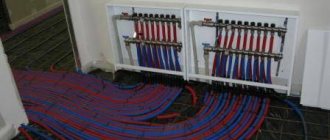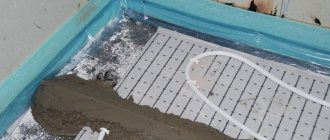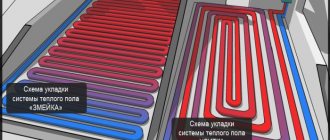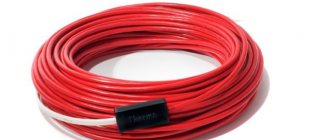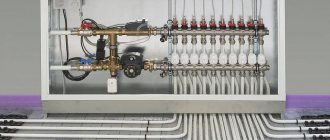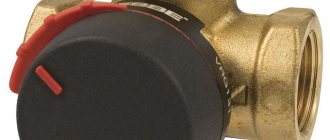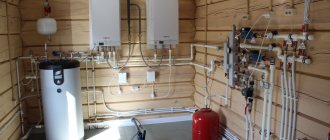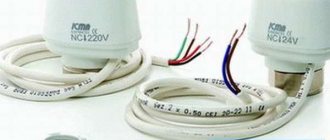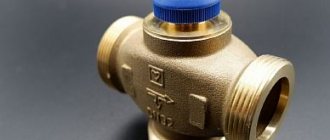Modern heating technologies have made great strides forward, so the use of electric heated floors is becoming increasingly widespread. The issue of thermal insulation is important: it allows you to significantly save energy while maintaining high quality heating.
For heated floors, it is recommended to use a substrate containing materials that reflect heat, so the best option for a heated floor substrate is foamed polyethylene or polypropylene with a metallization layer, covered with lavsan film.
This is a flexible, thin, heat-resistant and environmentally friendly material. It is placed directly under the heated floor, with the reflective side facing upward.
The substrate not only has reflective and heat-insulating properties, but also improves the hydro- and sound insulation of the room. Thanks to it, 85-90% of thermal energy is saved, which significantly reduces electricity costs.
Is it necessary to put heat-reflecting material under the heated floor on which the tiles are laid?
Gentlemen!
Please tell me, is it necessary to put heat-reflecting material under the heated floor on which the tiles are laid? Actually, they laid it, now the tiles are moving, were they laid incorrectly? Thank you. Rather than placing it incorrectly, it is better not to place it at all. You can have it in the rooms without a reflector. It makes sense to insulate and reflect only on balconies, so as not to flood the street or neighbors’ balcony. and now you have to take everything off and do it again.
Masters online: 207 Orders per week: 1,468 Offers per day: 645
Rather than placing it incorrectly, it is better not to place it at all. You can have it in the rooms without a reflector. It makes sense to insulate and reflect only on balconies, so as not to flood the street or neighbors’ balcony. and now you have to take everything off and do it again.
Thanks Yuri! I looked at the instructions for laying the floor on the manufacturer's website, they warn that tile adhesive should not be placed on the heat reflector (the heat reflector must lie under the screed at least 30 mm). Have you ever had to fix this kind of error, please tell me?
Warm floors like DEVI mats need to be filled with screed, and only then covered with tile adhesive over the screed. It's impossible to fix. Dismantle the tiles while they are still standing, make a screed, and only then glue the tiles
It's a little unclear. what gender and where? But in general, Yuri wrote it correctly - redo it.
The heated floor based on the heating mat was laid as follows: a heat reflector was thrown onto the screed, a heated floor was placed on it, and the whole thing was covered with tiles on a layer of glue of at least 1 cm. Kitchen premises. Thanks Ivan, have you ever had to correct errors of this kind?
Denis, please answer the questions - WHAT floor? WHERE (room)? WHAT is written in the instructions for this floor?
Ivan, Teplolux Mini. The instructions say this: Kitchen room in a panel house apartment.
Thus, that is, using the instruction method, we understand what was done not according to the instructions! PS/read the instructions and everything will be correct!
It's not worth paying for this kind of work. Make them change it.
If I get them to redo it, it will be their 4th retile. I have never met such workers before that I had to figure out all the details myself and, most importantly, the money they asked for was not small.
Well then, just send these specialists away and invite someone from the forum who will give you the most correct solution!
Thank you Vladimir, I realized that the builders who performed this work have absolutely no experience.
NO, this applies to a water floor, and this TP needs to be laid - 1) heat reflector 2) mesh 3) screed 4) TP 5) tile
This is nonsense: mats are placed without a reflector; you can pour SVR (self-leveling solution) directly under the tiles so that there is no vacuum, otherwise it will burn out in voids. And there is a heating cable that is made with a reflector and in a screed and is also called TP. And in this case, swear words. The mats have a maximum heating thickness of 1.8 cm. And depending on the power, the mini seems to be 160W. The mats will not warm up the screed, then you don’t have to waste money, but buy just one thermostat and install it for beauty.
Dear Denis, when installing any (water or electric) heat exchanger under the tile, a heat-reflecting layer is required for greater efficiency and heat transfer. If there is no reflector, then the TP heats no matter what, be it the balcony street, or the ceiling of the lower floor. The reflector reflects heat vertically upward. Next, a warm floor is installed, and it does not matter whether it is water or electric. Next, a screed is made on the TP. Only this way, and no other way. The exception is film TPs that are already glued to a reflective film. But I haven’t seen anything like this in Russia yet. Making a screed after the reflector under the TP is only necessary for those specialists who do not know how to properly install water TP.
You made a mistake, not on the reflector, but on the heat-insulating layer. That is, penoplex, expanded polystyrene, mineral wool, etc. The principle of operation of thermal reflectors is the same as that of a mirror, but unlike mirrors, they reflect infrared radiation rather than visible light. The essence of the installation technology specified by this manufacturer is that the TP must be laid on a solid, durable layer. That is, if you install the tiles directly on a 5-8mm mortar TP (According to the manufacturer’s recommendation). This means that there should naturally be a tie between the heat insulator and the TP. Since the heat insulator is inherently softer than DSP. But the heat insulator is placed where the floor borders on the cold of the street (for example, a balcony). Naturally, you first need to insulate it, then preferably a heat reflector, then a screed, then TP and tiles. If you install a TP in a bathroom, for example, then in order not to heat the neighbor’s ceiling, only a heat reflector is installed. Something like this.
Once again I focus on the TP instructions. It all depends on the TP. There is still a difference between water and electric, depending on the type, and you need to follow the manufacturer’s recommendations! The nuance is that the heat always goes up, but the manufacturer recommends under the screed or under the coating!
Heat goes to the top, naturally, but when the concrete bottom is colder than the top (screed), then the bottom takes away heat and the heat transfer is less evective. The owner naturally adds tension. The consequence of this is excessive consumption of electricity.
I completely agree, these are truisms. I just don’t understand why there are so many words? I outlined everything above and it’s up to the owner of the apartment to follow the instructions or enter into controversy. argue with brilliant eloquent performers.
Five points. It’s just that sometimes manufacturers write something like this, that it’s not clear what is what.
What does this have to do with instructions? If your knowledge of physics is at the 4th grade level. I have no desire to conduct an educational program with you. And everything I have written is addressed more to the author of the topic than to you.
place a tender on the website and choose who you like. drive those specialists to the neck.
Good evening Denis! Whether to lay a heat reflector or not depends on what kind of heated floor is used and where. If heating mats are laid, then no. If a cable is laid, then an ash reflector is used, but squares are cut out in the foil to better bind the screed solution to the floor. Or, to keep the screed stationary, a mesh is placed on the reflector and then filled with solution. Good luck.
URSA brand products
The company produces a wide range of different types of insulation materials designed specifically for thermal insulation of electric and water heated floors. Extruded polystyrene foam in rigid boards URSA XPS N-III-L is one of them. The slabs can be installed both on a concrete base and on the backfill or directly on the ground. Although the properties of the slabs allow the use of the last two options, the manufacturer still recommends starting with arranging a screed to level the base. In this case, the risk of slab deformation or destruction is eliminated.
To seal the joints, special protrusions are provided along the side edges, resembling steps. During installation, they engage and the plane becomes monolithic. The slabs are excellent for insulating large areas in one layer. Cold air and dampness do not penetrate through the joints.
Technical characteristics of the plates:
- compressive strength - 0.25 MPa = 25 t/m²;
- thermal conductivity - 0.032 W/mK;
- flammability group - G3;
- temperature range of use - -50...+75 oC.
Slabs are produced in a standard size of 1180x600x50 mm. One package, which includes 8 slabs, covers an area of 5.6 m2.
URSA GEO P-60 is also used for thermal insulation of heating systems. This is a semi-rigid fiberglass material based on fiberglass. With small thickness and weight, it provides not only reliable thermal insulation, but also noise protection. With a thickness of no more than 25 mm, noise absorption exceeds 35 dB.
In the production of insulation, the patented Water Guard technology is used, which reduces the level of moisture absorption to almost zero. In case of accidental contact with liquid water, or storage and transportation of the material in humid conditions, it absorbs very little moisture and steam. After being placed in normal conditions, URSA GEO quickly dries and returns to its condition.
- dimensions - 1250Х600Х20-25 mm;
- thermal conductivity - 0.032 W/mK;
- flammability group - NG;
- water absorption - no more than 1 kg/m3.
The insulation is part of the brand’s group of absolutely environmentally friendly materials produced in the GEO series.
URSA mats are available in roll form and are designed for installation on a solid base. They contain only natural ingredients that do not cause allergies and do not emit fumes when heated. During installation, certain safety regulations regarding working with fiberglass materials must be observed. Workers must wear gloves and respirators to protect themselves from tiny glass particles.
Also, TERRA URSA series slabs are used for floor insulation and sound insulation. The material is quite hard, non-flammable, and moisture resistant. URSA TERRA Floating floor is suitable for heating systems, the technical properties of which allow it to be used under a screed. The material is chemically resistant and does not react with cement, gypsum, tile adhesive and other building substances. The slabs are quite rigid and are produced in the standard format for URSA materials - 1250X600 in thicknesses of 25 and 50 mm. This allows them to be used both in small rooms and in spacious rooms.
Another convenient modern material is Ursa PureOne 34 PN. These are mineral slabs with an excellent thermal conductivity coefficient (0.034 W/(m*K)), optimal for underfloor heating systems. The material is distinguished by a wide temperature range of application - -60 ... +220 ° C. Such properties allow the use of slabs for thermal insulation under:
- water pipes;
- heating cables and mats;
- emitting films.
All URSA brand materials are universal. They belong to the best heat and sound insulators, are very easy to install and are practically not subject to external influences of a mechanical and chemical nature. When laying fiberglass materials, it is recommended to fill the screed, and only then lay the heating elements.
The choice of floor insulation should be made taking into account the expected loads on the coating, requirements for the heating temperature of the elements, and environmental safety. Also, the price of the material and installation costs play an important role among the selection criteria. In terms of price/quality/durability ratio, Ursa brand products are best suited for private and industrial construction.
All materials are developed for domestic construction technologies. At the same time, they interact well with imported building mixtures and underfloor heating components, without causing the risk of incompatibility. But among the company’s entire assortment, it’s easy to get confused and buy the wrong product. To guarantee success, it is best to consult with professional builders or official dealers of the brand.
Bibliography:
- E. Pisarev “Warm floor, water or electric” Robur, 2012, 47 pp., ill., (13.1 mb pdf);
- L. V. Leshchinskaya, A. L. Malyshev “Heating - water, electric, stove” Literary Boulevard, 2010, 336 pp., (44.1 mb. pdf);
- Nizovtsev M.I., Sakharov I.A. DETERMINATION OF THERMAL AND DESIGN PARAMETERS OF WATER HEATED FLOOR. Institute of Thermophysics SB RAS, Novosibirsk;
- . Bearzi V. Warm floors. Theory and practice // ABOK.- 2005. No. 7.- P. 70-82;
- SNiP II-3-79. "Construction heating engineering".
- GOST 13732-2-2008. “Ergonomics of the thermal environment. Methods for assessing human reaction upon contact with surfaces. Part 2. Contact with a moderate temperature surface."
Do you need an underlay for an electric heated floor?
Heated floors are a modern and economical way to heat residential premises. In the Moscow and Moscow region, as in other regions, they are gaining increasing popularity. This type of heating is an excellent alternative to radiator heating and has a number of advantages over it:
Basically, the design of a heated floor is a “layer cake”, where between the floor below and the floor covering on top there are: waterproofing, thermal insulation, a heating element (water pipe, electric cable, heating mesh), concrete screed.
Warm floors are divided according to the type of heating into:
Rules for installing a plug
Any heating system is installed in accordance with existing instructions and recommendations of specialists. There are some tips/tricks worth thinking about. Uniform distribution of heat over such a surface begins with laying an intermediate layer 4-5 cm thick.
Recommended: how to install a heated floor? It is also called a “subfloor”. Each heating element is located 30 cm apart. This applies to electrical cables and water pipes.
Laying a cork floor is impossible without completely drying the remaining part of the heated floor cake. The total percentage does not exceed 1.5%. Cement screeds based on anhydrite 0.3%. Warm-up begins gradually. The temperature should not exceed 5 degrees Celsius per day.
By the way, connecting a lock to a HDF base during the heating season is negatively related to temperature changes due to air humidity. The minimum rate is 60% at 23 degrees Celsius.
Start 2 weeks before the intended installation. Over the course of several days, the base cools down to 17-23 degrees Celsius when the system is turned off. All these actions are associated with high-quality installation.
The operation also has a few ground rules. The maximum temperature does not exceed 28 degrees Celsius. That is, 27 is the limit! Heating and cooling take place within 5 days. Preparation of the base is carried out according to the manufacturer's recommendations. Strict adherence to the instructions is the key to successful completion of the plug installation.
Water heated floor
Works on water heating pipes laid between the ceiling and the flooring. Water is heated in a boiler or boiler and supplied through the heating circuit using a pump.
The cooled water goes back into the boiler and so on in a closed cycle. The built-in heat control system will not allow the floor to heat up above the set temperature.
This type of heated floor is good for individual housing, but is completely unsuitable for an apartment building with central heating. Another disadvantage is that if a pipe breaks or leaks, it is often necessary to dismantle the entire structure.
We recommend: How to choose tile adhesive for heated floors?
Installation
You should start by preparing the base. There should be no flaws, unevenness, debris or other similar difficulties. The panels themselves are brought into the room a week before installation. They gradually warm up, reaching the desired level of acclimatization. That is, they are prepared for installation.
Fastening with glue involves gradually filling the area from the center of the room. There, in 100% of cases the surface is dry. As it fills, the heat dries out the corners. The method always works.
The adhesive mixture must be applied to the base and boards. Installation is carried out parallel to long walls. First, half the room is filled. Interlocking panels are easy to install even without a cork floor heating system.
By improving the final quality we mean the polyurethane base. The process starts from windows to doors. The parts are connected at an angle of 30 degrees. Detailed instructions are included. It is allowed to hit with a rubber hammer.
We recommend: How are PEX pipes connected for heated floors? There should be empty space along the walls. The distance is no more than 1 cm. The ideal option is 8 mm. After heating/humidity, slight deformation will occur. The remaining space will be filled. This is the right choice and ensures reliable fixation.
Electric heated floor
It is also a multilayer structure, where the heat transfer element is a flexible electrical cable or heating rod mats operating from the electrical network. This type of heated floor is not prohibited from being installed in an apartment building.
Unlike a water floor, this floor is not subject to leakage, and if any element breaks, it is enough to dismantle only one section above it.
Electric heated floors, in turn, are divided into:
Regardless of what type of floor has been chosen, an important component is the underlay for heated floors - a heat-insulating material.
Pros and cons of cork floors
It is not for nothing that cork becomes the favorite floor covering of those who once chose it. After all, it has many advantages.
Benefits of cork flooring
- Natural appearance and composition. External natural beauty and environmental friendliness create a special internal and internal microclimate. For designers, natural cork is a creative space. For living people - recovery. Cork floors do not contain phthalates, formaldehydes, heavy metals, polyvinyl chloride and other hazardous substances.
- Hypoallergenic. More and more people in Russia are experiencing allergic reactions. Allergies can occur at any age, so allergy sufferers, whether adults or children, should avoid not only allergenic products, household chemicals, but also materials in their own home. Cork floors are absolutely hypoallergenic and natural.
- Waterproof. Adhesive cork floors are completely resistant to water, wet cleaning, spills and even flooding. Cork laminate can be washed, but HDF board can swell when exposed to moisture, so the joints of such floors are covered with a sealant and their use in rooms with high humidity is excluded. Fire resistant. Cork is a highly flammable material, and when the open flame disappears, it immediately goes out. When burned, it does not emit toxic gases. Easy installation. A beginner can easily install cork laminate flooring. All that is required is to level and clear the base of debris. An adhesive floor will require following the instructions for working with the adhesive, as well as painting the floor immediately after installation. However, with this styling option, you can do it yourself.
Hygienic surface. It has antistatic properties that prevent the accumulation of dust. There are no cleaning restrictions. Cork floors can be washed with either plain water or detergent.High useful life. The surface does not fade from exposure to ultraviolet radiation and does not wear out due to its porous structure. Manufacturers indicate a 10-year period, but this is significantly underestimated. Practical use demonstrates much longer periods - more than 15-20 years.
Cork helps maintain an optimal microclimate, normal humidity and temperature. The floors guarantee natural air circulation and are not susceptible to the growth of fungus and mold.
Luxurious and exclusive look. The structure of the floors is not repeated, so the room will be individual.
Disadvantages of cork floors
We found articles online that mentioned the many disadvantages of cork flooring. We have been working with this material for more than 20 years and know everything about it. Of course, there are also low-quality Chinese floors - they have low-density cork, PVC, and a large amount of glue is added to the composition. But cork floors from well-known manufacturers in Portugal, Switzerland, and Germany are distinguished by their long service life and the highest quality. Our first clients have had glued cork floors for over 15 years, and after repairing them with varnish, the floor looks like new.
Therefore, only three real disadvantages of cork floors can be identified:
- Immunity to pinpoint impacts from sharp objects. They should be avoided while on duty.
- Does not fit well with underfloor heating systems. The thermal insulation of the material makes heating simply pointless. However, remember that cork floors are always warm to the touch.
- The price of cork flooring is quite high compared to artificial coverings - linoleum, vinyl tiles. For many, this originality of the floor turned out to be an unaffordable purchase. You can only save on changes. Economy class cork floors.
SUBSTRATE for heating CABLE
The underlay acts as a separating barrier between the subfloor and the heated floor. If the room has a subfloor made of concrete, then an underlay is required , since the heat through the concrete floor also warms the foundation. And to
To achieve a comfortable temperature on the floor, you will need to warm up the subfloor along with part of the foundation. The reflective layer is laid on the subfloor as a continuous carpet, with an overlap on the walls -
to compensate screed expansion. If necessary, reinforcing mesh is laid. A self-regulating cable or a cable on mats is laid out. Then they are filled with concrete or tile adhesive. After hardening, the substrate protruding along the perimeter is cut off. The underlay/insulation prevents heat from escaping into the subfloor and thus heat is not wasted . The use of a reflective substrate allows you to increase the room temperature by up to 30%.
The underlay performs a waterproofing function, protecting the floor from the penetration of moisture and steam into it, both from above and from below. The substrate also levels the surface. When using material more than 2 mm, the substrate performs an acoustic function, reducing the amount of noise and vibration.
Laying features
The substrate can be laid with the reflective side in any direction. The reflective effect will remain in any case. It must be laid with a continuous carpet and have the same thickness over its entire area. It is imperative to take into account the overlap on the walls to compensate for the expansion of concrete. The individual panels are joined end-to-end, and the seams must be taped.
Operating procedure
Material
The substrate/insulation consists of NPE with a closed cell structure; it is this structure that gives a low thermal conductivity coefficient, good elasticity and zero moisture absorption. The reflective layer consists of a composite of aluminum and lavsan, this combination gives the material unique characteristics - it does not conduct electric current , and is very resistant to concrete and alkaline solutions. The material has increased mechanical strength . The low density of the substrate allows the material to act as sound insulation .
The most important characteristics of the underlay/floor insulation
PHOTO installation under WARM FLOOR
You can order or find out more by calling the toll-free number: 8-800, which is listed in the contacts.
Step-by-step instructions for laying cork backing
Cork substrate is produced in both sheet and roll formats. The sheets are laid according to the offset. The rolls are either rolled out and cut near the wall “after the fact” or cut into flaps in advance.
In no case do not forget about the gap of 0.8-1 centimeter, which should run around the entire perimeter: around door jambs, ledges and pipes. This is a must.
Otherwise, with a change in temperature or high humidity, the cork layer will simply swell, and the floor itself will become unusable.
Before work, restore, clean and thoroughly vacuum the base, check it for moisture. The latter is easy to do as follows: attach a piece of polyethylene to the screed using tape, or simply place an empty glass jar upside down. If condensation forms on the inside of the improvised appliances after a day, it means that the subfloor has not dried thoroughly. Those who can determine whether the floor is dry with a specialized device should know that the regulatory limit is five percent.
Then we perform the following sequence:
- We spread the polyethylene. Don't forget about the allowances on the walls. It should look like a pallet with sides of ten centimeters. Already laid strips overlap with subsequent ones with an overlap of 10-15 centimeters. We fix the film with tape, both for reliability and for ease of use;
- We roll out the first half of the cork backing, taking into account the technological indentation. Leave about a centimeter in reserve from the starting end, from the adjacent wall of the longitudinal side;
- Having rolled out the roll to the opposite wall, we cut the backing, taking into account the technological gap;
- We temporarily attach the insulating material with tape to the base in those places where it is necessary to maintain an indentation;
- We lay the laminate over the “cork” strip.
Types of substrates
The underfloor heating is a flexible flooring that is located between the floor slab and the heating element. The substrate has a number of functions:
Since the substrate has several purposes, it must meet certain requirements:
We recommend: How to calculate the length of a heated floor?
Mineral types of substrate include fiberglass. It is a rolled material made of fiberglass. Fiberglass does not get wet, does not burn, but has minimal thermal insulation. Used as a contour between the water-heated floor and the coating.
Natural types include cork, jute, and felt substrates. These are easy to use, environmentally friendly materials.
Without special impregnation, they are quickly exposed to destructive biological influences, that is, they become infected with fungus and bacteria, which significantly reduces their service life.
The above types of materials are used as a substrate between the screed and the floor covering, for example, under laminate.
Proper care of cork flooring
Heated cork flooring is a heating system with its own nuances. One of these is proper maintenance after use. The performance of the material directly depends on it. Even sudden movement of furniture reduces them. It is better to glue special rubber bands or felt on the legs.
Then the decorative layer will not be subject to mechanical damage. Cleaning only with a soft damp cloth. Vacuum cleaner with brushes. No abrasive surfaces or hard metal materials.
The average service life is 10-15 years of use. But it depends on observing many subtleties. Some consider this to be a serious disadvantage.
At the same time, forgetting about the huge number of advantages. Cork covering for heated floors is sometimes difficult to replace with anything. Especially after some use.
- Related Posts
- What are the advantages of Gulfstream underfloor heating?
- Features of heated floors made of metal-plastic pipes
- Which floor covering to choose for heated floors?
- How to install a heated floor sensor?
- What is film heated flooring?
- What characteristics does Shtein underfloor heating have?
Installation of heated floors under tiles
Today I will tell you step by step how to lay a heated floor under the tiles. We will install the electric heated floor, which I wrote about in this article. Well, let’s not delay, let’s start the installation......
Installation of heated floors under tiles
What you need
Warm floors for tiles were purchased from us. We will also need a thermostat for a heated floor, a substrate for a heated floor, a grinder with a cutting wheel for brick and concrete (for cutting walls and floors), as well as a drill or hammer drill for drilling a wall (with a Pobedit drill bit). If all this is available, you can begin installation.
Choosing a place
Before laying the heated floor, you need to decide on the installation location! I install it in the shower room; there is no need to cover the entire space with flooring, because it is not at all necessary to warm up part of the floor under the shower stall, under the toilet and under the sink with a cabinet. Because this is money thrown away - why heat the floor where we don’t walk? Therefore, I will put it approximately like this, I have already measured everything.
Floors lie precisely in the space where people will walk.
Benefits from sellers and manufacturers
The first thing that both manufacturers and sellers claim is high environmental friendliness. Also, one of the main advantages of cork flooring is its very presentable appearance, which only expensive parquet floors can compete with. In addition, these floors have a long service life. And the cork regulates how best to regulate the air humidity in the room. In addition, the material has high bactericidal properties and is a natural antistatic agent.
Thanks to its special honeycomb structure, cork floors are highly elastic and lightweight. Also, do not forget about the body and sound insulation qualities - here they are very high. For this reason, these coatings are very relevant in residential and commercial premises.
It is very important that the cork cells do not burn. These floors are very bad and difficult to burn. But if a fire does occur, the plug does not release toxic products. Also, the cork does not sink in water. This is important in apartments in multi-story buildings, where neighbors often leave “surprises” for each other. If the apartment is poured from above, after the cork coating dries well, it will not lose its qualities and characteristics.
In winter, you can walk on these floors barefoot. The coverage that cork offers allows you to even lie down or sit on the floor. This is an excellent floor covering that retains heat well. Apartments with small children do not even need warm floors.
The cork floor is very elastic, walking on it is a pleasure, and besides, such walking takes the load off the spine. If there are small children, they will not cry if they fall, and the cup will not break if it accidentally slips out of their hands.
Such coatings are also suitable for allergy sufferers. They are not charged with electricity, which means they will not be dusty. In addition, cork floors have excellent dirt-repellent properties.
Underfloor heating: selection rules, characteristics, best brands, installation tips
Author: Nikolay Strelkovsky
Warm floors are of two types, depending on the heating method.
Selecting and laying the underlay under the heated floor
Mermen
Heating is carried out by a pipeline system, the coolant is hot water.
Water heated floor
They are used in most cases in private homes; when connecting hot water in multi-apartment buildings, big problems arise due to the disagreement of management companies to give permission to connect to common building heating networks for two reasons. Firstly, in this case it is difficult for them to control the specific consumption of thermal energy by each consumer individually. Secondly, boilers may not be able to withstand a significant increase in energy consumption.
Water heated floor diagram
It is not always possible to install a separate heating boiler in city apartments, and such installation, together with the price of the equipment, is quite expensive.
Electrical
Standard electrical diagram for connecting an infrared film heated floor
The temperature rises due to the resistance of the current conductors. From school we know the formula Q (energy released) = I (current strength) × R (conductor resistance) .
Connection diagram for cable heated floors
Depending on the physical characteristics of the conductors, heated floors can be film (infrared) or cable (conducting elements are ordinary flexible cables and improved insulation). Electric floors have their own difficulties; during their installation, it is necessary to take into account the parameters of the existing wiring and special protective fittings.
Infrared heated floor diagram
To effectively heat floors, the power per square meter must be at least 250 kW; in total, larger values are used.
Currently, manufacturers produce a wide range of substrates, differing in linear characteristics, materials of manufacture and the ability to perform additional functions.
Power of electric heated floor
Electricity consumption of film heated floors
Warm floor marking
Purpose
The underlay is placed between the concrete surface in the room and the heating system. The main purpose of the material is to prevent the loss of heat that comes from the heating elements of the heated floor. Otherwise, the heat will be wasted without showing any effect. This way, only the ceiling on the floor below will warm up.
If the substrate is chosen correctly, then heating of the subfloor will not only be uniform, but also twice as fast.
Another purpose of this material in a heated floor system is as a barrier. It does not let in cold, moisture, or steam from the lower floors. This is especially true for the first floors above basements. Since the substrate has excellent soundproofing qualities, in apartment buildings you will not have to listen to screams and noise from neighbors. Other materials can be used for the substrate:
But even this cannot be called an exceptional option. Technologies do not stand still and materials are constantly being improved, which can be chosen as a substrate for electric heated floors. The choice of a specific material will depend on the levelness of the base, where the installation is carried out, as well as on the type of floor covering in the finishing.
What to look for when choosing substrates
A very important point, we consider it necessary to consider this issue before moving on to a direct description of the various types of underfloor heating. It should be borne in mind that absolutely all manufacturers are trying to increase sales of their products; to do this, they often advertise them in every possible way, including using not entirely benign methods.
What should you really pay attention to when selecting the optimal substrate option?
Thermal conductivity indicators. The lower they are, the more efficiently the substrate works. These parameters depend on the thickness and materials of manufacture of the products. To enhance the effect, modern substrates have a foil top layer - due to the reflection of infrared rays, heat saving indicators increase by approximately 20–30%. As for heat conservation, all materials used meet today's stringent requirements of housing construction standards.
Subspecies
Popular ones are:
- algomerate;
- veneer;
- a combined coating of the above proposed elements.
In the first case, the crumbs are compressed at high temperature. The price is affordable for most buyers. The second implies uniform sheets.
They are extracted directly from natural wood. The number of shades excites the imagination. The high cost is due to numerous advantages.
According to the installation method, cork flooring for heated floors is divided into:
- adhesive panels. The material consists of 100% wood. It is secured using construction adhesive. Standard thickness is from 4 to 6 mm. Afterwards it is covered with a double layer of varnish. Does not absorb moisture. The base must be equally level over the entire plane.
- glueless. Reminds me of laminate. The structure is made of a protective layer with agglomerate, MDF sheet, and cork backing. There is a decorative pattern/element at the top. The lower part insulates from noise and prevents harmful bacteria. A popular option for children's rooms.
In fact, each of the subspecies is worthy of attention. Their use is determined by the specific preferences of people. Which, in turn, consist of small nuances/subtleties.
Substrates for underfloor heating with electric heating
Under these types of heated floors, thin substrates made of technical pressed cork, Folgoplast, Polifom, Thermod, TMpro and other foamed polymers are used.
Reflective thermal insulation Foil-plastic
Cross-linked polyethylene foam "Polifom"
The latter, by the way, are much superior to their competitors in their ability to withstand loads; due to this feature, the scope of their use is expanding. Substrates with increased thickness parameters are made from extruded polystyrene foam. The material has high physical strength characteristics and can be used as a base for a concrete screed. The underlay is used under all types of electrically heated floors, including ordinary ones with flexible conductors.
If the base is not very level and requires leveling, then you can use substrates made of plywood, OSB and chipboard.
Important. For electric floors, it is not recommended to use substrates with an aluminum reflective layer. In the event of an insulation failure, an unexpected current leak occurs with possible negative consequences. The reflective layer should be on vacuum-coated polyethylene film.
Lavsan substrate Izobond PP
When choosing a specific brand, you need to take into account two initial factors.
Choose the underlay depending on the floor finish
Warm floor pie, example
Heated floor schemes
These parameters should be taken into account when designing the height of door and window openings. During repairs, it is necessary to take all construction measures to reduce the thickness of the heated floor - you will not have to solve problems with reducing the height of doors, etc. The ideal option is that the installed heated floor does not interfere with the opening/closing of doors, acceptable - the door leaf and vertical trims are needed for several trim centimeters from the bottom. The most unpleasant option is that it becomes necessary to raise the lintel of the doorway; the heating system requires alteration.
Under linoleum, only hard substrates are used and either a thin screed is made. The technology for laying substrates depends on the materials of manufacture; during work, you must follow the manufacturers' instructions.
What type of thermal insulation is better to choose and why?
When choosing foil material for heated floors, you need to consider:
- heat reflecting properties;
- thermal conductivity coefficient;
- resistance to high temperatures;
- presence of sound insulation;
- environmental safety;
- reaction to moisture;
- prostate in styling;
- fire safety indicators.
Video - ways to reflect thermal energy, how insulation works
Attention!!//The truth about foil insulation//where does such insulation work?//Ivan Serba 2022.
The price of insulation for heated floors also plays an important role. For example, polyethylene foam coated with aluminum, or polystyrene foam substrate with a reflective layer, are affordable in cost.
But when buying multifoil or foilisolone, you will need to spend a decent amount. Mineral or basalt type insulation, although inexpensive, is not suitable for warm floors.
In addition, the thickness of the foil layer also plays a big role. In cases where conventional spraying is used on top of the heat-insulating fabric as a reflective layer, the efficiency of the product is significantly reduced. The lower the quality of the reflective surface, the easier it is for heat to pass through it.
For your information! Products that are intended for insulation of walls or ceilings should not be used for heating floors. After all, there they will be subject to mechanical stress, which can lead to the loss of their properties. Therefore, you only need to install insulation intended for the floor.
Also, when choosing a thermal insulation material, it is important to consider that:
- More often, the product in tiles is used for heated floors;
- foil mats are used to make floating screeds; they are laid between the joists.
Substrates for underfloor heating with water heating
Due to the fact that water floors in most cases have a top cement-sand screed, the substrates are subject to more stringent requirements than for electrically heated floors.
How to lay heated floors on plywood
Laying the substrate and installing underfloor heating pipes
When choosing the thickness of the substrate, you need to take into account the effectiveness of the thermal insulation of the base. If the house is wooden and the floors are thermally insulated with mineral wool, then the thickness of the substrate may be insignificant. And vice versa, if the substrate serves as the main thermal insulation material, then its thermal conductivity should be minimal. The aluminum heat-reflecting film on the front part has a great positive effect; its presence is welcomed by all professionals.
Foil underfloor heating fomisol with markings
Foiled polystyrene foam with markings
Warm water floors can be installed under laminate, linoleum, ceramic tiles or natural and artificial stone coatings. The physical characteristics of finishing floor coverings have a significant impact on the choice of technical characteristics and linear parameters of the substrate. The greater the weight of the flooring, the stronger the underlay should be.
Pay attention to the thickness of the heated floor cake
The correct selection of all elements of a heated floor, taking into account the widest possible list of individual features, increases the efficiency of its functioning, reduces the estimated cost of construction and installation work and increases the duration of operation. The optimal choice can only be made if it is made consciously on the basis of knowledge about the varieties and technical characteristics of various types of substrates.
Advantages of this material
The advantages are due to the competent use of such finishing. Based on this, the following stand out in particular:
- excellent thermal insulation parameters;
- resist the spread of fungi / moisture / other formations inside and on the surface;
- good quality in most cases;
- environmental friendliness;
- resistance to fire and high temperatures;
- hypoallergenic (for families with children);
- pleasant sensations when walking barefoot.
- budget;
- several color options;
There are also small advantages. Among them are a soft outer layer, the inability to absorb foreign odors, the specific aroma of wood and durability.
As you can see, the cork is ideal for the last layer of the warm floor cake. But it is important to understand that this material is also divided into different options.
Don't forget about elasticity. Even after filling from neighbors there are no problems with use. Dishes break very rarely, children do not feel pain from minor falls. Modern production eliminates the presence of toxins in the chemical composition.
Elasticity reduces stress on the spine. After a hard day at work, walking around the house is a pleasure. These benefits can only be fully appreciated through direct use. To do this, it is best to try something similar in specialized stores before making a full decision.
In addition to the flooring, your new apartment will need furniture; the abundance of online furniture stores can get you confused. We advise you to buy furniture only from trusted companies such as https://volgadonmebel.ru/

